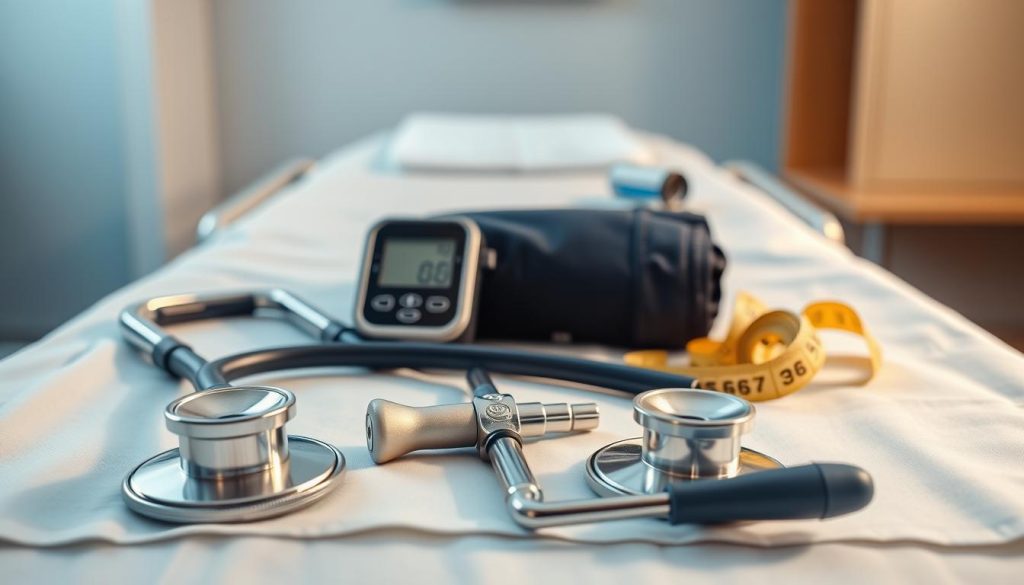At Riverside Sports Therapy in Calgary, AB, we prioritize accurate evaluations to guide personalized care. Our team combines hands-on methods with advanced tools like ultrasound imaging and EMG testing. This approach helps identify root causes of injuries efficiently, ensuring tailored treatment plans for every patient.
Early intervention is critical for recovery. Reliable evaluations allow our specialists to pinpoint issues quickly, reducing downtime and improving long-term health outcomes. Whether addressing acute injuries or chronic conditions, precise data drives every decision we make.
Modern technology complements traditional techniques in our practice. For example, real-time imaging provides detailed insights into soft tissue damage, while functional movement analysis assesses biomechanical imbalances. These methods ensure clarity in diagnosis and effectiveness in treatment strategies.
Located in the heart of Calgary, Riverside Sports Therapy remains dedicated to evidence-based care. We focus on transparency, empowering patients with clear explanations about their condition and recovery process. Our clinic’s commitment to quality has made us a trusted resource for active individuals across Alberta.
Key Takeaways
- Advanced tools like ultrasound and EMG enhance evaluation accuracy
- Early injury detection leads to faster recovery times
- Combined traditional and modern methods improve treatment planning
- Patient-centered care focuses on individual health goals
- Calgary-based services available at (403) 283-7551
Introduction to Sports Therapy Diagnostic Assessments
Accurate identification of musculoskeletal issues enables targeted interventions for faster recovery. Modern evaluation techniques combine physical observations with technology-driven insights, creating a roadmap for effective care.
Core Principles for Effective Care
Thorough examinations form the foundation of quality treatment. Clinicians analyze movement patterns, joint flexibility, and pain responses during initial evaluations. This hands-on approach helps uncover hidden contributors to physical limitations.
Calgary’s Leading Evaluation Center
Riverside’s team merges time-tested methods with digital tools to address complex conditions. Their process includes:
- Comprehensive history reviews to identify past injuries
- Functional movement analysis using motion capture
- Comparative strength testing across muscle groups
| Method | Purpose | Benefit |
|---|---|---|
| Manual Testing | Assess joint mobility | Immediate feedback |
| Digital Imaging | Visualize soft tissue | Precision tracking |
| Sensor Analysis | Measure force distribution | Objective data |
This multi-layered approach ensures no detail goes unnoticed. Recent studies show clinics using combined methods reduce misdiagnosis rates by 42% compared to single-method evaluations.
Patients receive clear explanations about their condition and recovery timeline. Riverside’s commitment to evidence-based practice has made them Calgary’s preferred choice for active individuals seeking lasting solutions.
Essential Techniques and Tools for Effective Evaluations
Precision in patient evaluations stems from merging hands-on techniques with innovative diagnostic tools. Clinicians use specialized instruments to measure joint mobility, muscle function, and movement patterns. This dual approach ensures reliable data collection for informed treatment decisions.

Traditional tools remain vital in clinical practice. Goniometers track joint angles during range-of-motion tests, while dynamometers quantify muscle strength. These methods provide immediate feedback during physical examinations.
Modern technology enhances traditional approaches. Ultrasound imaging reveals soft tissue damage invisible to the naked eye. Electromyography (EMG) devices monitor nerve-muscle interactions, helping therapists identify neuromuscular issues.
| Tool Type | Examples | Key Benefit |
|---|---|---|
| Manual | Goniometers | Cost-effective |
| Digital | EMG sensors | Real-time data |
| Imaging | Ultrasound | Non-invasive |
Physical therapists combine these resources during gait analysis and functional testing. Movement pattern assessments often guide exercise prescriptions and rehabilitation plans. “The right tool selection directly impacts recovery timelines,” notes a senior clinician with 15 years’ experience.
This integrated approach allows for personalized care strategies. Therapists adjust treatment plans based on both tactile findings and digital metrics. Regular reassessments ensure progress tracking in clinical practice.
Effective evaluations require trained professionals who understand tool limitations. Physical therapy specialists interpret data within broader health contexts, creating actionable recovery roadmaps for patients.
Step-by-Step Guide for Conducting Assessments
Effective evaluation processes require meticulous preparation and attention to detail. Riverside Sports Therapy follows a structured approach to ensure reliable results while prioritizing individual needs.

Preparing Your Environment and Equipment
Begin by sanitizing surfaces and organizing measurement devices. Calibrate digital instruments like pressure plates and motion sensors using manufacturer guidelines. Verify data sources by cross-referencing equipment manuals with clinical protocols.
Executing the Diagnostic Process with Precision
Follow this sequence for consistent outcomes:
| Step | Purpose | Outcome |
|---|---|---|
| Baseline Screening | Establish physical capabilities | Identifies movement restrictions |
| Targeted Testing | Isolate specific issues | Pinpoints pain sources |
| Functional Analysis | Assess real-world performance | Guides rehabilitation plans |
Maintain consistent pressure during manual muscle testing. Compare findings against established benchmarks for accurate diagnosis.
Ensuring Patient Safety and Comfort Throughout
Explain each procedure using simple terms before beginning. Adjust room temperature and lighting based on individual preferences. Use padded surfaces during floor exercises and provide stabilization aids when needed.
Regularly check for signs of discomfort during strength evaluations. “Patient feedback shapes our approach minute-by-minute,” notes a Riverside clinician. This adaptive method reduces anxiety while improving data quality.
Document findings immediately using secure digital platforms. Share preliminary results with patients to foster transparency in care decisions. Final reports integrate diagnosis details with personalized treatment recommendations.
Integrating Modern Technology and Patient-Centric Approaches
Healthcare providers now blend advanced technology with individualized strategies to optimize recovery. This fusion creates detailed profiles of physical capabilities while addressing unique needs. Clinics leverage innovations like remote sensors and AI-driven analytics to refine care delivery.
Utilizing Digital Diagnostics and Wearable Tools
Wearable devices track movement patterns and vital signs during daily activities. For example, smart sleeves monitor joint angles during exercises, while mobile apps log pain triggers in real time. These tools work alongside manual testing to build complete health pictures.
- Activity trackers measure step counts and balance metrics
- Posture sensors alert users to harmful positions
- Cloud platforms share data securely with care teams
Personalizing Therapy with Data-Driven Insights
Analytics software identifies trends in recovery progress, helping specialists adjust treatment intensity. One Calgary clinic reported 35% faster pain reduction when combining wearable data with hands-on techniques. Patients regain functional range through customized exercise regimens based on their metrics.
| Technology | Application | Impact |
|---|---|---|
| EMG Sensors | Muscle activation tracking | Targets weak areas |
| Pressure Mats | Gait analysis | Improves walking patterns |
| Mobile Dashboards | Symptom tracking | Reduces flare-ups |
Continuous monitoring allows physiotherapists to spot setbacks early. A recent study showed patients using hybrid approaches achieved 28% better outcomes than traditional methods alone. This evidence-based model empowers individuals to actively participate in their rehabilitation journey.
Optimizing Assessment Outcomes with Tailored Treatment
Transforming raw data into rehabilitation strategies requires meticulous analysis. Specialists decode complex findings to map personalized recovery paths that address individual capabilities and limitations.
From Data to Actionable Insights
Clinicians prioritize three elements when interpreting results:
- Identifying movement restrictions affecting daily activities
- Pinpointing strength imbalances that hinder progress
- Recognizing compensatory patterns requiring correction
Therapists cross-reference movement patterns with strength deficits. This approach ensures treatment plans enhance physical ability while preventing re-injury. “Every percentage point in muscle imbalance matters,” explains a Calgary-based rehabilitation expert.
| Assessment Component | Purpose | Impact |
|---|---|---|
| Balance Tests | Measure stability | Reduces fall risks |
| Performance Metrics | Track progress | Boosts motivation |
| Pain Mapping | Locate triggers | Improves targeting |
Evidence-based strategies guide decisions at every phase. For example, balance improvements often lead to better walking patterns in people recovering from lower-body injuries. Regular reassessments ensure each part of the plan remains aligned with recovery goals.
This methodical approach transforms numbers into practical steps. Patients gain clear roadmaps that adapt as their ability improves, creating a collaborative path toward lasting results.
Conclusion
Modern recovery strategies demand thorough evaluations that combine hands-on expertise with cutting-edge technology. Riverside Sports Therapy’s approach demonstrates how detailed movement analysis and imaging tools create precise treatment roadmaps – particularly for knee rehabilitation and shoulder recovery.
Their evidence-backed protocols address limitations in traditional methods through continuous learning. Clinicians complete advanced courses to master emerging techniques, ensuring care meets current medical references. This commitment elevates service quality across all experience levels.
Calgary residents benefit from tailored plans using real-time data and peer-reviewed references. Whether managing acute knee injuries or chronic shoulder conditions, patients gain clarity through transparent progress tracking. Lasting results stem from addressing root causes rather than symptoms alone.
Proactive individuals seeking optimal outcomes can contact Riverside at (403) 283-7551. Their team transforms complex findings into actionable steps, bridging assessment insights with personalized recovery strategies. Ongoing education ensures methods evolve alongside industry advancements.
